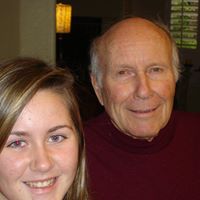Robert Earl Keys
age ~90
from Jackson, MS
- Also known as:
-
- Robert E Keys
- Bob Keys
- Rob Keys
- Robert Keyes
- Keys Robert
- Phone and address:
-
4234 Rainey Rd, Jackson, MS 39212
6013725726
Robert Keys Phones & Addresses
- 4234 Rainey Rd, Jackson, MS 39212 • 6013725726
- Dallas, TX
- Cleveland, MS
Work
-
Position:Retired
Education
-
Degree:High school graduate or higher
Us Patents
-
Method For Removing Borehole Rugosity Noise From Well Log Data
view source -
US Patent:55792480, Nov 26, 1996
-
Filed:Jan 9, 1995
-
Appl. No.:8/369965
-
Inventors:John A. Nieto - Carrollton TX
Denis P. Schmitt - Richardson TX
Robert G. Keys - Dallas TX
Keh Pann - Richardson TX -
Assignee:Mobil Oil Corporation - Fairfax VA
-
International Classification:G01V 136
G01V 140 -
US Classification:364574
-
Abstract:A method for eliminating sinusoidal noise without affecting the response of the formation means that the actual formation responses of the logging tools are recovered, and the logs can be used quantitatively. Removal of sinusoidal noise from a log is accomplished in three steps. First, the log is reduced to a zero-mean, stationary series. Second, the wavenumber of the sinusoidal noise is identified by its peak in the Fourier amplitude spectrum. And third, the noise is removed by applying a zero-phase notch filter. In order to preserve the quantitative data integrity, the low wavenumber trend is kept. Preserving the quantitative data integrity is accomplished by approximating the log with a least-squares cubic spline which retains the overall log character, ignoring the sinusoidal noise. A zero mean stationary series is formed by subtracting the least-squares cubic spline from the data. The remaining steps, Fourier analysis and filtering are performed on the difference series.
-
Method For Removing Random Source And Receiver Noise From Seismic Traces
view source -
US Patent:52873285, Feb 15, 1994
-
Filed:Jan 28, 1993
-
Appl. No.:8/010097
-
Inventors:John E. Anderson - Richardson TX
Michael A. Jervis - Austin TX
Robert G. Keys - Dallas TX -
Assignee:Mobil Oil Corporation - Fairfax VA
-
International Classification:G01V 136
-
US Classification:367 38
-
Abstract:Recorded seismic traces are gathered into common offset groups. Within each group, the traces are arranged according to shot point number. Mean and standard deviations are determined for each trace. High frequency amplitude variations in the mean and standard deviations caused by variations in source strengths and receiver calibrations are removed to produce traces of low frequency amplitude variations representing subsurface geology or wave propagation effects.
Name / Title
Company / Classification
Phones & Addresses
KEYS TO CONSULTING LLC
Director
CONVERSATIONAL COMPUTING CORPORATION
Isbn (Books And Publications)


Resumes

Partner At Keys & Burkett
view sourceLocation:
United States

Robert Keys
view source
Robert Keys
view sourceWork:
United States Postal Service

Robert Keys
view source
Robert Keys
view source
Robert Keys
view source
Robert Keys
view source
Robert Keys
view source
Robert Keys
view source
Robert Keys
view source
Robert Keys
view source
Robert Keys
view source
Robert R. Keys
view source
Robert Keys
view source
Robert Keys
view source
Robert Keys
view sourceClassmates

Robert Brownlee (Keys)
view sourceSchools:
Russell High School East Point GA 1973-1977
Community:
Stanley Abercrombie, Jane Bazemore, Jody Mckim, Dale Rubley

Robert Keys
view sourceSchools:
Hulstrom Elementary School Northglenn CO 1963-1966, Northglenn Middle School Northglenn CO 1967-1968
Community:
Kathy Martin, Marilyn Colussy

Robert Keys
view sourceSchools:
Kickapoo High School Viola WI 1997-2001
Community:
James Mcneilly, Julie Cunningham

Robert Keyes (Keys)
view sourceSchools:
Albert College Belleville Morocco 1939-1943
Community:
Laura Batten, Murray Smith, Elizabeth Cohoe, William Mcintosh, Martha Craigie

Robert Keys
view sourceSchools:
Bassfield High School Bassfield MS 1993-1997
Community:
George Gatewood, Cathy Collums

Robert Keys
view sourceSchools:
Alexander Elementary School Abbotsford Saudi Arabia 1960-1967
Community:
Leanne Fox, Joel Bancroft, Patricia Scanlan, Chad Burns

Robert L. Keys (Seme as a...
view sourceSchools:
Valley High School Fairfax AL 1954-1958
Community:
George Coulter, James Weaver, Donald Davis
Myspace
Youtube
Googleplus

Robert Keys
Work:
USPS - Postal Carrier
Education:
University of Oregon - English
Tagline:
If it's information you want you can get it from the police

Robert Keys

Robert Keys

Robert Keys

Robert Keys

Robert Keys

Robert Keys

Robert Keys
Flickr
Get Report for Robert Earl Keys from Jackson, MS, age ~90

















